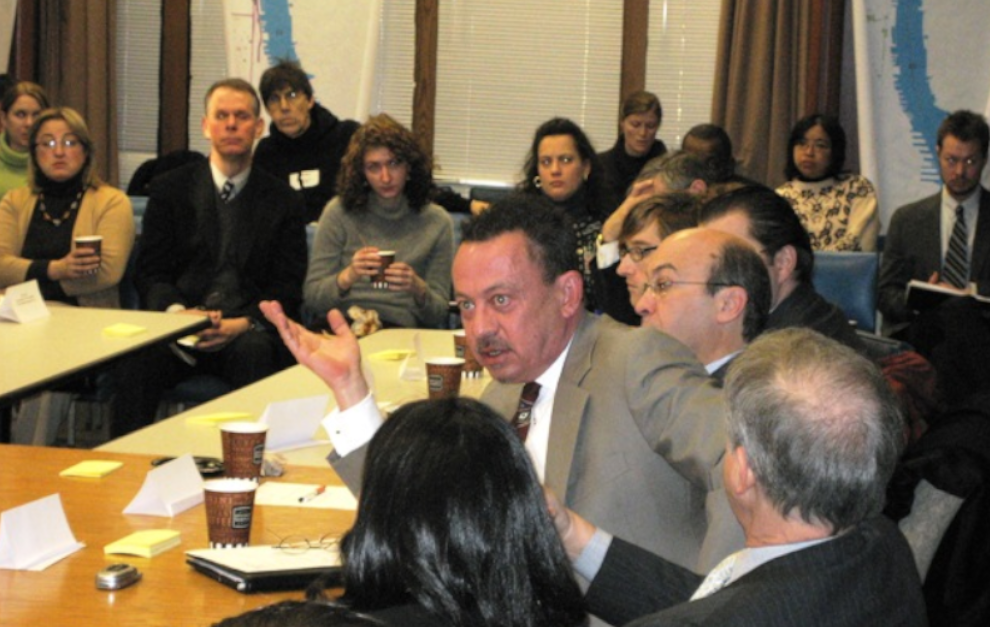Philadelphia loses a waterfront advocate


Steven A. Weixler, an award-winning interior designer and staunch advocate for his Society Hill neighborhood and the Central Delaware Waterfront, died in late April, following a years-long battle with a neurological disorder.
“Anytime somebody walks to Race Street Pier and enjoys that, or goes to a performance at the FringeArts building across the street, or enjoys Washington Avenue Green, or years from now, when someone walks over the new Penn’s Landing that’s going to come and take shape … anyone who experiences any of that should think of Steve,” said Matt Ruben, who followed Weixler as chairman of the Central Delaware Advocacy Group.
Weixler was born in Louisville, KY, and studied architecture at the University of Louisville, but spent much of his 60 years working and volunteering in Greater Philadelphia. He founded WPL Interior Design – that W stands for Weixler – where he was noted for a remarkable talent with lighting and renderings so beautiful that his partners plan to keep framed examples on the walls.
Preservation of Society Hill’s historic architecture was important to Weixler, who led Society Hill Civic’s zoning and historic preservation committee before becoming its president for nearly three terms. In the past year, SHCA Vice President Jim Moss often served as acting president, but as sick as he was, Weixler came to at least two of SHCA’s large quarterly meetings at the Pennsylvania Hospital auditorium, Moss said. “It was clear to me, to anyone who knew him well, that Steve was in great distress,” Moss said. “He presided, and then he had to leave and visit the emergency room.” That, Moss said, is evidence of how much Society Hill meant to him. “He was dedicated, and determined and resolute.”
Moss said Weixler saw development as positive, provided it was “the right kind of development, appropriate for a historical district.”
They worked together on many controversial proposals, but the biggest, figuratively and literally, was the failed Stamper Square, Moss said. Society Hill fought the 42-story tower originally proposed. In the end, it was finances that did the project in, and the huge parcel at 410 Front Street remained vacant despite its prime location in a desirable neighborhood. Toll Brothers is now building a condominium complex at the site, with public, open space that Weixler helped shape. “He was at the lead of all of those who were just delighted we finally could move forward,” Moss said.
Weixler was delighted that there would “finally be something to fill in that ugly blight,” said Walter Peterson, one of his WPL partners and his closest friend. Delighted, yes. Completely satisfied? Never.
“Even after he would finish something published in Architectural Digest, he would say, ‘I wish we could have done this differently, or done that,'” Peterson said.
What began as representing Society Hill on a riverfront advisory committee led to Weixler’s role as founding chairman of the Central Delaware Advocacy Group, or CDAG.
Under Weixler’s leadership, CDAG worked to ensure that the quasi-city Delaware River Waterfront Corporation focused on the public’s goals for the waterfront when developing the Central Delaware Master Plan. It pushed city planning to adopt that plan, so that all entities making decisions about the waterfront must consider plan goals. Weixler worked directly with the DRWC, city council, planning and zoning officials to create an interim overlay designed to protect the waterfront from anything that would detract from the city’s vision. When Weixler and his CDAG colleagues determined a proposal didn’t fit with what Philadelphia residents said they wanted during the public input process that led to the master plan, it was often Weixler himself who testified before the planning commission or city council and its committees.
Weixler never saw CDAG as more important than the civic associations whose representatives formed CDAG’s board, though.
“We’re looking not to be big brother, but big helper,” he said at one meeting, noting that CDAG could help civics who don’t have architects or planners as members better understand development proposals that they must consider.
Ruben, who is president of the Northern Liberties Neighbors Association, met Weixler when both were part of the pre-CDAG Central Delaware Advisory Group, the much larger group of representatives from not only civic associations but business, development and government. The advisory group was established in 2006 by former Mayor John Street to work with PennPraxis – Penn’s School of Design’s practical arm – and city planning to get Delaware Waterfront planning off the ground. “It became clear immediately that he was functioning as the go-to civic representative in that larger body,” Ruben said. There was a lot of mistrust around the table in those early days, he added.
Both Ruben and PennPraxis Executive Director Harris Steinberg give Weixler much of the credit for saving a planning process that came close to falling apart.
Back then, Steinberg notes, “there was no comprehensive plan, no zoning reform – zoning changes were made (largely) through the councilmanic process. Casinos were coming, and the longshoreman were up in arms,” concerned that the city’s new waterfront plan would mean more green space but fewer jobs.
The city administration was asking civic groups to participate in waterfront planning and telling them their voices would shape the Central Delaware, but at the same time, moving forward with approvals related to two waterfront casinos that many civics opposed. In many ways, the city was bound by state legislation, Steinberg said, but that did not ease the tension. The civics pushed PennPraxis to take a stand against casinos on the waterfront, but Steinberg said that wasn’t possible – Praxis had to be focused on form, not function.
Philadelphians didn’t think waterfront planning would amount to anything more this time than it had in the past. And they didn’t trust the former Penn’s Landing Corporation – the quasi-city agency charged with managing the city’s Delaware waterfront which was often criticized for being secretive and ineffective.
It looked like the civic associations might abandon the process, Steinberg said, until Weixler, along with Old City’s Joe Schiavo, stepped in, serving as brokers between the civics and Praxis. Steinberg said he’ll always remember Weixler as a “gentleman diplomat” and a “Southern gentleman. A very gentle, intelligent, quiet but determined and focused person, who really knew how to navigate the shoals of human behavior.” It’s an apt metaphor for Weixler, an avid yachtsman.
When the Central Delaware Advisory Group group evolved into the advocacy group of civic organizations, Weixler was the “obvious choice” for chair, Ruben said. Weixler always made everyone feel their contributions were important, Ruben said. “No idea was off-limits. No voice was shut down.”
His desire to let everyone fully express themselves sometimes led to some long meetings. Worried about the toll these meetings took on Weixler’s health, Peterson would tell his friend that sometimes, not everyone needed to be heard. “But he would say it was very important, as once they were heard, it was easier to enlist them” to help.
Following one of the directives that came out of the Central Delaware visioning process, Mayor Michael Nutter imploded the Penn’s Landing Corporation and replaced it with the Delaware River Waterfront Corporation.
DRWC President Tom Corcoran said he met frequently with Weixler in the early days of the then-new organization. He had to work to earn Weixler’s trust. “When we first started working together, it was always cordial, but at that point, CDAG still had some reservations about the DRWC. They were still used to the old Penn’s Landing process. So he really viewed his role, and CDAG’s role as a watchdog, to make sure we were going to do everything supposed to do.”
Corcoran said as time went on and trust was gained on both sides, CDAG and DRWC forged a strong partnership that exists to this day.
In late 2009, CDAG’s first year as an advocacy group independent from the Praxis-led process, Weixler reflected on the group’s progress: “It’s good to hear we are developing a reputation as a credible, sensible presence,” he said. “I didn’t want us to be written off as a bunch of idealistic eggheads with an impossible dream.”
Weixler and Peterson founded their design firm a few years after meeting at a party in 1981. Weixler’s spatial perception and ability to “put onto paper no more and no less than what was exactly needed” made him a great designer, Peterson said. His honesty and intellect made him a good and interesting friend. “He was intellectually gifted and fascile,” Peterson said.
Did his honesty and sharp mind mean friendship included debate? “Oh good God yes,” Peterson said. “Sometimes you could hear us debate down the block.”
At one key point in the waterfront planning process, the combined goals of the thousands who participted were unveiled in a large public meeting. A video montage featuring key players in the formation of the Central Delaware Vision plan was shown.
“We always straddle the line between legacy and possibility,” Weixler says at the 3:13 mark in that video (see below). “And we deal with the legacy of good and bad things that have happened in Philadelphia, and we set off in the direction of leaving the next generations with something better.”
Weixler is survived by three brothers, Peterson, third WPL partner and friend, Marcello Luzi, and other friends. His mother died this past February, his father, years ago. A memorial service will be held at 11:30 a.m., May 24 at St. Mark’s Church, 1625 Locust St., Philadelphia. A reception will follow in the Parish Hall. In lieu of flowers, memorial donations may be made to: Calcutta House, Development Office, 1601 West Girard Avenue, Philadelphia, PA 19130.
WHYY is your source for fact-based, in-depth journalism and information. As a nonprofit organization, we rely on financial support from readers like you. Please give today.



